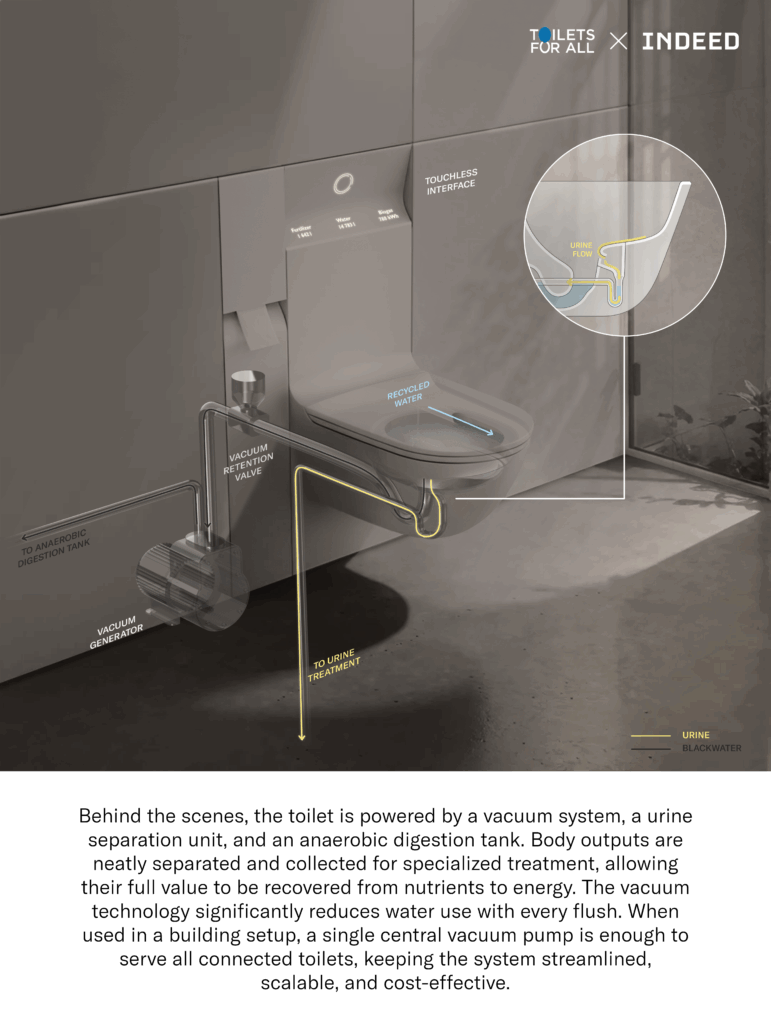Toilets For All
Circular Sanitation Innovation: Turning Toilets Into Resource Hubs for Sustainable Cities
“It’s time to stop flushing opportunities down the drain and start owning our own shit. The loop won’t close itself, but together we can make it happen.”
Reto Wey, Co-Founder, ToiletsForAll
INDEED Innovation partnered with ToiletsForAll, a Swiss foundation advancing circular sanitation solutions, to develop a comprehensive vision for transforming urban wastewater systems. Together, we created a blueprint for how cities can turn everyday waste into valuable resources while reducing environmental impact and creating economic value for communities.
This collaboration demonstrates how circular economy principles can be applied at the building scale to create resilient, decentralized systems that complement existing infrastructure while opening new pathways for sustainability and resource independence.
The Challenge
For over a century, centralized sewer systems have defined how we handle human waste. While this infrastructure dramatically improved public health, enabling cities to grow and flourish, today’s model is showing its limits under mounting pressures:
- Environmental Strain: Wastewater systems contribute approximately 3% of global human-made emissions (CO₂, CH₄, N₂O) while wasting water, energy, and nutrients
- System Overload: Heavy rainfall overwhelms sewers, causing raw sewage discharges. Thames Water alone reported nearly 300,000 hours of overflows in 2024
- Resource Loss: Even when treatment works, valuable water is discharged downstream rather than reused where needed
What we flush away daily is rich in nitrogen, phosphorus, potassium, and clean water that could be recovered locally to support food production, generate energy, and reduce dependence on fossil fuel-based fertilizers. The challenge was to reimagine this relationship with “waste” through product design and systems thinking.
Our Approach
We developed a holistic circular sanitation vision through three interconnected layers: product experience, technical systems, and urban ecosystem mapping.
Step 1: Designing the User Experience
The Touchpoint: Seamless Integration
We designed the toilet interface to deliver the same comfort and ease people expect from modern bathrooms, but smarter behind the scenes. The front-end features:
- Intuitive, touchless interface responding to simple hand gestures for flushing
- Real-time impact visualization showing household contributions to fertilizer production, water savings, and biogas generation
- Sleek, modern aesthetic seamlessly integrated into any bathroom design
- Hydrodynamic separation using the “teapot effect” principle to separate urine without changing user experience


Step 2: Engineering the Technical System
Modular Architecture for Adaptability
Behind the user interface, we mapped an integrated technical ecosystem designed for modularity and scalability:
Vacuum System Integration
- Reduces water use by up to 90% (saving 57 million liters over a building’s lifespan)
- Single central vacuum pump serves all connected toilets in a building
- Ideal for flood-prone areas, high-water-table zones, or rapidly urbanizing regions
- Can be powered by on-site renewables (solar, biogas)
Urine Nutrient Recovery
- Separation at source preserves nutrient concentration
- Transformation into EU-approved liquid fertilizer (Aurin)
- Removes pharmaceuticals and hormones during processing
- 90% of remaining liquid becomes valuable distilled water
- One person’s annual urine can fertilize enough soil to grow over 1,000 carrots
Organic Waste Processing
- Feces combined with kitchen waste via shared disposal points
- Anaerobic digestion generates biogas for household energy
- Produces nutrient-rich digestate for high-quality humus and soil conditioner
- Alternative pathways: dry toilets with aerobic composting based on community preference
Each component is designed to be swapped, scaled, or adjusted to fit different climates, community needs, and urban contexts.
Step 3: Mapping the Urban Ecosystem
From Building to City: Closing the Loop
We developed a comprehensive system map visualizing how a building-scale implementation (30+ people) connects to the broader urban ecosystem:
Building-Level Loops:
- Nutrients from urine nourish rooftop gardens and greeneries
- Biogas powers household energy needs
- Recovered water irrigates plants and serves as non-potable household supply
- Residents experience reduced utility costs and enhanced self-sufficiency
City-Scale Connections:
- Surplus resources sold or shared with municipal services and local agriculture
- Organic recycling partners transform digestate into commercial products
- Food grown with city-made nutrients returns to residents’ plates, completing the circular flow
Stakeholder Network: The map identifies key players including technology providers (vacuum systems, urine recovery, digestion tanks), certification bodies, organic recycling partners, urban agriculture networks, municipal services, and building developers.
Results & Impact
The collaboration resulted in a detailed blueprint demonstrating how circular sanitation can work at scale:
Product Innovation
- User-centered design maintaining comfort and familiarity while enabling resource recovery
- Modular technical architecture adaptable to diverse urban contexts
- Integration of proven technologies from companies like Finizio and VunaNexus
Economic Case
- €2,470 annual value generation per household (fertilizer, water, biogas, energy savings, rooftop produce)
- Potential to avoid €3,345+ in mandatory sewer connection fees
- €109M+ market opportunity in Germany alone
Environmental Benefits
- 90% reduction in water consumption
- Elimination of dependence on fossil fuel-based fertilizers
- Avoidance of industrial contamination (heavy metals, PFAS)
- Reduced greenhouse gas emissions from wastewater treatment
From Vision to Market Momentum
This strategic foundation has catalyzed broader industry interest and positioned circular sanitation as a viable alternative to conventional systems. The project is now being used to:
- Assemble a consortium of forward-thinking companies to scale circular sanitation globally
- Engage municipalities, developers, and policymakers in pilot program discussions
By combining product design excellence, technical systems thinking, and ecosystem mapping, INDEED and ToiletsForAll have created a roadmap for turning one of society’s oldest waste streams into a powerful engine for urban resilience, environmental restoration, and economic value creation.
More success stories
Forming an Alliance of Frenemies

Covestro
